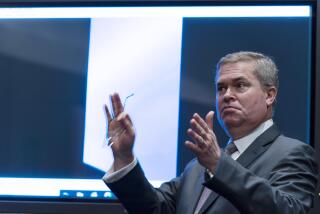Ultra Wideband Innovation May Lead Charge in Yet Another Revolution
- Share via
A change in federal regulations that could usher in yet another--dare we use the word--revolution in electronic devices is believed to be just around the corner.
Within a few weeks, or possibly even days, the Federal Communications Commission is expected to issue a “notice of proposed rule making” that would greatly expand the range of frequencies now available for wireless communications and radar systems that could detect the heartbeat of a victim trapped under a pile of earthquake rubble.
Nearly all available frequencies have already been auctioned off for such things as cell phones and satellite communications, creating a spectrum bottleneck that could threaten the growth of a wide range of industries.
To get around the problem, a few innovators have gone to the “garbage frequency,” the part of the radio spectrum that is filled with unintentional radiation from everything from human bodies to laptops. Called ultra wideband, that part of the spectrum is called the “noise floor,” and it consists largely of background radiation that can interfere with cell phones and even radio reception.
Current federal regulations prohibit the “intentional” emission of signals in the ultra wideband range by anyone who hasn’t purchased the right to operate on a specific frequency. Under those rules, it’s OK for your microwave oven to leak a little radiation, but you can’t build a wireless transmitter that deliberately operates in that range unless you own the frequency.
But last year, as part of an effort to open ultra wideband and expand the usable spectrum, the FCC issued waivers to three companies for “limited marketing” of devices designed to function in that range. The companies are Time Domain Corp. of Huntsville, Ala., whose founder is credited with inventing the technology that makes all this possible, US Radar Inc. and the Zircon Corp.
Opposition to the move initially came from several directions, most notably the folks who watch out for the Global Positioning System, which also operates at ultra wideband frequencies. Opponents feared that opening that range to wide use could interfere with signals from the satellites and could pose serious threats to aircraft safety.
But those fears have been at least partly attenuated because of the peculiar nature in which the new devices operate. Instead of operating on a single frequency, which might also be used for a GPS signal, the new devices operate on a shotgun philosophy, emitting pulses on many frequencies, each lasting half a billionth of a second.
That disperses the signal over a wide range of the radio spectrum, so no pulse has a noticeable effect on any single frequency, the promoters say.
*
The possibilities are limitless, said Ralph Petroff, president of Time Domain.
Petroff is an engineer turned entrepreneur and is one of the major investors in Time Domain, so he has a vested interest, but his enthusiasm is hard to suppress.
Several years ago he met Larry Fullerton, a former NASA engineer who held a patent for the technology. Fullerton had developed a high-speed silicon and germanium chip (marketed now as PulsON) capable of transmitting at extremely low power, no more than 50-millionths of a watt. The signals are transmitted at intervals between 50 billionths and 150 billionths of a second.
The varying times of the pulses allow the chip to encode the zeros and ones of digital information at a transmission rate of 10 million bits per second.
What intrigued Petroff was the fact that the signals could penetrate concrete walls, actually revealing the movement of a human on the other side.
“I felt like a caveman seeing fire for the first time,” Petroff said.
Under the waiver granted by the FCC, Time Domain developed RadarVision, a first-generation device designed to see through solid objects.
The device was taken recently to the home of the Fairfax County Rescue Squad in Virginia, a famed team of rescuers who have traveled the world to pull victims out of earthquake rubble and bombed buildings.
“They’ve got a rubble pile about 12 feet in diameter, filled with concrete and rebar, and a little crawl space underneath,” Petroff said. “We sent one of our people under there with orders to remain still and try to breathe. We were able to spot the breathing through 12 feet of concrete.
“That’s extremely exciting.”
The system also was demonstrated for the Los Angeles County Sheriff’s Department, which gave it high marks but was disappointed in its $10,000 price tag. Petroff said that when the system moves into full production, that price will come down substantially.
The device could allow police agencies to pinpoint the location of a suspect inside a building before kicking the door down, thus saving lives, Petroff said.
But radar is only one of many possible applications.
*
Fullerton believes it should be possible to build a low-power wireless network that would link computers, phones and TV sets without the need for hard wiring. He has estimated the cost at $30.
He also sees cars equipped with tags that would pinpoint a car in a crowded parking lot.
Petroff wants to see the technology integrated into cell phones so the location of the user could be readily determined by the user as well as the 911 emergency operator.
That would require antennas scattered around the city, so some infrastructure would be required. But proponents think that’s a minor hurdle.
Petroff, for one, expects to see a flood of new devices on the market after the FCC finishes its rule making. Executives with the agency have indicated that should be completed this year.
So hold on to your seats. It’s possible that we “ain’t seen nothing yet,” as the saying goes.
*
Lee Dye can be reached via e-mail at leedye@gci.net.
More to Read
Sign up for Essential California
The most important California stories and recommendations in your inbox every morning.
You may occasionally receive promotional content from the Los Angeles Times.













